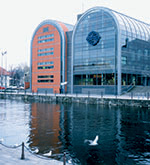Helping nature help itself
A new sewage treatment plant in Bydgoszcz, Poland, uses biological process to fight water pollution. The ability to efficiently manage the volume of sludge facilitates the biological digestion process. It also means cutting costs for transportation and incineration.
DATE 2023-11-28 AUTHOR Simon Cygielski Before the Fordon sewage treatment plant was built in 2000, Bydgoszcz, a northern Polish city of nearly 400,000 inhabitants, dumped most of its liquid waste into the Brda and Vistula rivers with little or no processing. Today, says Stanislaw Drzewiecki, president of the Municipal Water and Sewage Company (MWiK), the water that ends up in the Vistula is cleaner than the river water itself. "We actually dilute the river," says Drzewiecki, brandishing data that verify how the sewage leaving the Fordon plant meets, and in many cases exceeds, Poland 's strict new legal norms.
Before the Fordon sewage treatment plant was built in 2000, Bydgoszcz, a northern Polish city of nearly 400,000 inhabitants, dumped most of its liquid waste into the Brda and Vistula rivers with little or no processing. Today, says Stanislaw Drzewiecki, president of the Municipal Water and Sewage Company (MWiK), the water that ends up in the Vistula is cleaner than the river water itself. "We actually dilute the river," says Drzewiecki, brandishing data that verify how the sewage leaving the Fordon plant meets, and in many cases exceeds, Poland 's strict new legal norms.
Bacteria and computers
 Fordon uses several, environmentally friendly methods of treatment. For example, airborne fatty acids generated in the digestion of primary sludge are used for reducing the content of bioactive elements, such as phosphorus and nitrogen, in the final stages of treatment. This makes the process entirely biologically based, even though a chemical method is always on stand-by for emergency situations. Sludge digestion also delivers the natural methane gas that later heats the plant's buildings and runs the digestion process itself at a constant temperature. In addition, the plant uses the gas to run an electric generator for its electrical needs.
Fordon uses several, environmentally friendly methods of treatment. For example, airborne fatty acids generated in the digestion of primary sludge are used for reducing the content of bioactive elements, such as phosphorus and nitrogen, in the final stages of treatment. This makes the process entirely biologically based, even though a chemical method is always on stand-by for emergency situations. Sludge digestion also delivers the natural methane gas that later heats the plant's buildings and runs the digestion process itself at a constant temperature. In addition, the plant uses the gas to run an electric generator for its electrical needs.
Drzewiecki says that the plant's high level of automation also has a dramatic effect on its efficiency. Automatic tests determine the composition of the incoming sewage, which allows rapid optimization of the biological processes within the plant. "Comparisons show that system automation in itself can increase efficiency two-to threefold," he says. The problem with sewage is that, although dangerous element scan be reduced by digestion, no process can get rid of the waste completely." Unfortunately we can't make it disappear," says MWiK operations director Slawomir Rybarski. " But we can reduce its volume. It's a storage problem."
Sludge product with great potential
The Fordon sewage treatment produces 12,000 tons of processed sludge a year. It is a biologically neutral material, rich in nutrients that make it an effective fertilizer. "This is a product that has great potential as a fertilizer, but farmers and other potential users still have a negative view of it," Drzewiecki says "They don't look at what 's in it, but rather at what it's perceived to be."
Facing a shortage of clients for its product, MWiK and the city authorities are considering other options. One would be to burn it in the city 's envisioned trash incinerators, along with the town 's other solid waste.
"A more advantageous idea would be to burn it as supplementary fuel in a power plant," Drzewiecki says, adding that this would likely be the most cost-effective method of disposal. Using the sludge to generate heat and electricity would lower fuel costs and would not necessitate the building of a separate incinerator, he explains.
A solid investment
 According to data from Poland's Central Statistical Office, Poland released 301.3 million cubic meters (400 million cubic yards) of untreated waste into its rivers and lakes in 2000, although that figure represents only a fraction of the damage that was taking place only 10 years previously. New, stricter rules and better enforcement have pushed communities and businesses to cut down on pollutants released into the environment. Heavy fines that face polluters have made investments in clean technologies and waste treatment a worthwhile proposition.
According to data from Poland's Central Statistical Office, Poland released 301.3 million cubic meters (400 million cubic yards) of untreated waste into its rivers and lakes in 2000, although that figure represents only a fraction of the damage that was taking place only 10 years previously. New, stricter rules and better enforcement have pushed communities and businesses to cut down on pollutants released into the environment. Heavy fines that face polluters have made investments in clean technologies and waste treatment a worthwhile proposition.
As most Polish municipalities, including Bydgoszcz, do not have the funds to finance such large projects, they have been relying on other sources of capital. Fordon, for example, was built largely with funds from the European Union's PHARE program, administered locally by the National Environmental Protection Fund. The plant was built in 2000, achieved its target parameters in May 2001, and was officially handed over to MWiK in June 2001.
So far, the reviews from its crew and management have been uniformly positive, but some people, such as Fordon manager Mariusz Staszczyszyn, feel they should reserve judgment until they've had a longer time to get accustomed to its intricacies." It's difficult to judge anything after only a year of operations," he says.
Ultimately, what counts is how the plant affects the lives of the people around it. Although Staszczyszyn says he doesn't believe the average person notices the effect Fordon has on the river, he likes working on the project. He recalls a map of Poland he once saw, with black spots marking polluters. "Bydgoszcz was one of them," he says. "But I think in a few years we'll see effects. Perhaps we'll go back to times when you could bathe in the Vistula."
The waste water treatment process
Alfa Laval is the only supplier with the product scope to deliver both decanter centrifuges, drum thickeners, spiral heat exchangers and relevant auxiliary equipment combined with the process know-how to ensure that the combination of these products work towards optimizing the waste water treatment process.
The combination of drum thickener and decanter centrifuge optimizes the dewatering installation, allowing for the most cost efficient choice of decanter centrifuge. The spiral heat exchanger is essential in control and regulation of the digester temperature, which again affects the biological processes of the plant.
Three process stages
The Fordon plant processes sewage through three stages: mechanical, biological and chemical.
First the primary sludge is separated from the rest of the wastewater and is sent off to seal digesting tanks, where Alfa Laval spiral heat exchangers maintain a stable temperature improving the digestion process and increasing gas production.
The remaining sludge is thickened from 0.7 percent solid content to 5 percent using two Alfa Laval drum thickeners, each of which can process up to 30 cubic meters (40 cubic yards) of secondary, or biological, sludge per hour.
The digested sludge is then combined with the sludge from the drum thickeners. At this stage Alfa Laval decanters are used to dewater the sludge, settling out solids by centrifugal force, dewatering the sludge to 20-30 percent solid content, depending on the quantity of polymer used.
Necessary equipment
During the plant's start-up, the biological sludge that was being processed in the drum thickeners did not respond as expected to treatment with powdered polymers. "Alfa Laval helped us to solve this problem," plant manager Mariusz Staszczyszyn says. The plant's workers ran adjustments necessary to convert the process to use liquid polymers, while Alfa Laval delivered the necessary equipment.
The whole thickening and dewatering process from 0,7 percent to 20-30 percent solid content means that the water content (and thus the volume) of the sludge has been reduced by about 95 percent.
